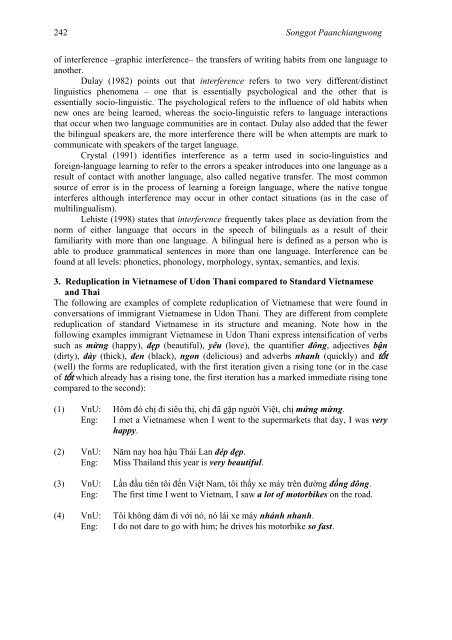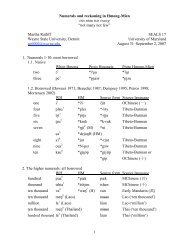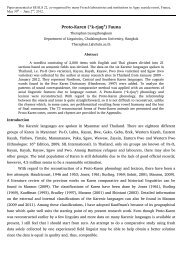proto-southwestern-tai revised: a new reconstruction - seals 22
proto-southwestern-tai revised: a new reconstruction - seals 22
proto-southwestern-tai revised: a new reconstruction - seals 22
Create successful ePaper yourself
Turn your PDF publications into a flip-book with our unique Google optimized e-Paper software.
242 Songgot Paanchiangwong<br />
of interference –graphic interference– the transfers of writing habits from one language to<br />
another.<br />
Dulay (1982) points out that interference refers to two very different/distinct<br />
linguistics phenomena – one that is essentially psychological and the other that is<br />
essentially socio-linguistic. The psychological refers to the influence of old habits when<br />
<strong>new</strong> ones are being learned, whereas the socio-linguistic refers to language interactions<br />
that occur when two language communities are in contact. Dulay also added that the fewer<br />
the bilingual speakers are, the more interference there will be when attempts are mark to<br />
communicate with speakers of the target language.<br />
Crystal (1991) identifies interference as a term used in socio-linguistics and<br />
foreign-language learning to refer to the errors a speaker introduces into one language as a<br />
result of contact with another language, also called negative transfer. The most common<br />
source of error is in the process of learning a foreign language, where the native tongue<br />
interferes although interference may occur in other contact situations (as in the case of<br />
multilingualism).<br />
Lehiste (1998) states that interference frequently takes place as deviation from the<br />
norm of either language that occurs in the speech of bilinguals as a result of their<br />
familiarity with more than one language. A bilingual here is defined as a person who is<br />
able to produce grammatical sentences in more than one language. Interference can be<br />
found at all levels: phonetics, phonology, morphology, syntax, semantics, and lexis.<br />
3. Reduplication in Vietnamese of Udon Thani compared to Standard Vietnamese<br />
and Thai<br />
The following are examples of complete reduplication of Vietnamese that were found in<br />
conversations of immigrant Vietnamese in Udon Thani. They are different from complete<br />
reduplication of standard Vietnamese in its structure and meaning. Note how in the<br />
following examples immigrant Vietnamese in Udon Thani express intensification of verbs<br />
such as mừng (happy), đẹp (beautiful), yêu (love), the quantifier đông, adjectives bận<br />
(dirty), dày (thick), đen (black), ngon (delicious) and adverbs nhanh (quickly) and tốt<br />
(well) the forms are reduplicated, with the first iteration given a rising tone (or in the case<br />
of tốt which already has a rising tone, the first iteration has a marked immediate rising tone<br />
compared to the second):<br />
(1) VnU: Hôm đó chị đi siêu thị, chị đã gặp người Việt, chị mứng mừng.<br />
Eng: I met a Vietnamese when I went to the supermarkets that day, I was very<br />
happy.<br />
(2) VnU: Năm nay hoa hậu Thái Lan đép đẹp.<br />
Eng: Miss Thailand this year is very beautiful.<br />
(3) VnU: Lần đầu tiên tôi đến Việt Nam, tôi thấy xe máy trên đường đống đông.<br />
Eng: The first time I went to Vietnam, I saw a lot of motorbikes on the road.<br />
(4) VnU: Tôi không dám đi với nó, nó lái xe máy nhánh nhanh.<br />
Eng: I do not dare to go with him; he drives his motorbike so fast.





